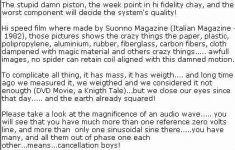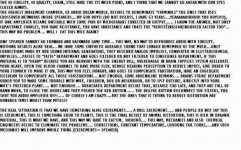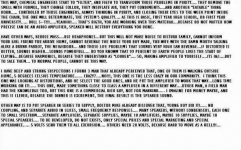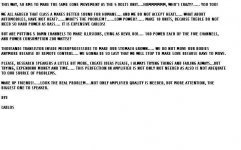So your telling me that the 0.1% track is actually the worse one? and the 9.6% is the one which sounds slightly hazey? how does that make sense, or are they two different types of distortion?
I just went on what you would expect to be there, thinking you must have got the order wrong when loading them into foobar, because intuition would tell you the 9% would be worse then the 0.1%. Now that your telling me the 0.1% is the worse would you mind explaining to me why? or is that located somewhere on the website which I had a brief look at.
Cheer Matt
I just went on what you would expect to be there, thinking you must have got the order wrong when loading them into foobar, because intuition would tell you the 9% would be worse then the 0.1%. Now that your telling me the 0.1% is the worse would you mind explaining to me why? or is that located somewhere on the website which I had a brief look at.
Cheer Matt
5th element said:So your telling me that the 0.1% track is actually the worse one? and the 9.6% is the one which sounds slightly hazey? how does that make sense, or are they two different types of distortion?
Yes, that's what we've been saying all along. The one with the nasty and obvious distortion is 0.1% THD.
THD represents individual harmonic distortion figures taken in total. The problem is that some are much more important than others, so much so that totalling them together gives you a nonsense figure.
Konnichiwa,
Abso-*****ing-lutley.
Yup. You got that right.
Because "THD" is a measure of distortion that has absolutley NO CORRELATION WHATSOEVER to percieved distrotion, which was the point I tried to get across.
Both tracks have been subjected to algorythms that produce distortion but use very different approaches. However, if you measure the results with classic THD and IMD tests the MEASURED distortion is as indicatced. The point is that low THD & IMD is NO GARANT WHATSOEVER for undistorted sound with music.
Based on exactly that particular EXPECTATION (or shall we call it prejudice?) which is absolutely false and which to expose was the point of the test.
Exactly. Hence such measurements like THD & IMD where used in advertising and led to the measurement methodes to be standardiesed and so on, all based on the assumtion that low measured THD actually correlates with low percieved distortion, except it does not.
At a guess form the sound, all the distortion is high order and odd order only, but I do not know for sure.
The website explains the background to this, yes.....
Sayonara
5th element said:So your telling me that the 0.1% track is actually the worse one?
Abso-*****ing-lutley.
5th element said:and the 9.6% is the one which sounds slightly hazey?
Yup. You got that right.
5th element said:how does that make sense,
Because "THD" is a measure of distortion that has absolutley NO CORRELATION WHATSOEVER to percieved distrotion, which was the point I tried to get across.
5th element said:or are they two different types of distortion?
Both tracks have been subjected to algorythms that produce distortion but use very different approaches. However, if you measure the results with classic THD and IMD tests the MEASURED distortion is as indicatced. The point is that low THD & IMD is NO GARANT WHATSOEVER for undistorted sound with music.
5th element said:I just went on what you would expect to be there,
Based on exactly that particular EXPECTATION (or shall we call it prejudice?) which is absolutely false and which to expose was the point of the test.
5th element said:because intuition would tell you the 9% would be worse then the 0.1%.
Exactly. Hence such measurements like THD & IMD where used in advertising and led to the measurement methodes to be standardiesed and so on, all based on the assumtion that low measured THD actually correlates with low percieved distortion, except it does not.
5th element said:Now that your telling me the 0.1% is the worse would you mind explaining to me why?
At a guess form the sound, all the distortion is high order and odd order only, but I do not know for sure.
5th element said:or is that located somewhere on the website which I had a brief look at.
The website explains the background to this, yes.....
Sayonara
"Both tracks have been subjected to algorythms that produce distortion but use very different approaches. However, if you measure the results with classic THD and IMD tests the MEASURED distortion is as indicatced. The point is that low THD & IMD is NO GARANT WHATSOEVER for undistorted sound with music."
This makes sense with regard to speakers since there are such a huge range of physical construction options. However, if you limit the comparrison to being within a class such as "MTM configuration with sealed enclosure" would you limit the possible distortion mechanisms sufficiently that relative THD might be meaningful that class. I'm thinking that perhaps the distribution of harmonic components might be similar. I'm not arguing foe this, just speculating.
The speculation arrises from the casual observation of FFT plots of various amplifiers of similar design. For instance, dual rail, BJT, conventional Lin topology seems to produce pretty similar relative harmonic components. Add mirrior image IS and VAS aqnd you get a different typical pattern. This may weel have no parrallel in the case of speakers. Still, if someone really wants to investigate this for various types that would be very informative. Are there typical harmonic signatures for sealed, vented, transmission line vs ESL etc?? Even if there is no typical pattern, THAT would be interesting.
This makes sense with regard to speakers since there are such a huge range of physical construction options. However, if you limit the comparrison to being within a class such as "MTM configuration with sealed enclosure" would you limit the possible distortion mechanisms sufficiently that relative THD might be meaningful that class. I'm thinking that perhaps the distribution of harmonic components might be similar. I'm not arguing foe this, just speculating.
The speculation arrises from the casual observation of FFT plots of various amplifiers of similar design. For instance, dual rail, BJT, conventional Lin topology seems to produce pretty similar relative harmonic components. Add mirrior image IS and VAS aqnd you get a different typical pattern. This may weel have no parrallel in the case of speakers. Still, if someone really wants to investigate this for various types that would be very informative. Are there typical harmonic signatures for sealed, vented, transmission line vs ESL etc?? Even if there is no typical pattern, THAT would be interesting.
32 years ago or more, my associates and I wondered why speakers could have so much distortion and amps could not! Even more, some amps with LOW distortion sounded worse than amps with high distortion. It has to do with extra distortions generated by the amps, BUT not measured with normal audio measurements. Feedback IS an important factor.
Sorry for my last post... was a long day etc.. I hope we can forget that one ok?
So I did the measurements... at 'moderate' levels (not disturbing the neibers)..using a Sennheiser ME67, small JM Labs speakers, Technics new class A int amp, Labview software, PC onboard audio interface, NCH tone generator v2.01.
typical I got about -20dB THD at 40Hz and -60dB THD at 400Hz, but as I moved my microphone away (Sennheiser ME67), THD degreased. This indicated that the distortion created in the microphone is dominating.. doing some more tests, I found out that as I moved the microphone away, and simultaneously increas power to the speaker, 3rd H decreased (symm flattend tops), while 2nd H increased. This indicated that the microphone mainly produces 3rd H, and the speaker mainly 2nd H.
My conclusion so far is, that acoustic THD measurements are far more difficult because micriphones produce so much distortion. -60dB was my measurements limmit. While I can measure electronical THD down to -105dB easely.
To improve on this, I will need a more silenced room, so my noise floor is lower. Then I need to increase the distance to from the mic to the speaker as much as possible, lowering the SPL at the mic, while keeping a good S/N. I'm not sure if I can do that in my home setting. I am especially dissapointed by the fact that the microphone (expensive proffesional item) produces so much THD). Another eye opener?
Greetings,
Thijs
So I did the measurements... at 'moderate' levels (not disturbing the neibers)..using a Sennheiser ME67, small JM Labs speakers, Technics new class A int amp, Labview software, PC onboard audio interface, NCH tone generator v2.01.
typical I got about -20dB THD at 40Hz and -60dB THD at 400Hz, but as I moved my microphone away (Sennheiser ME67), THD degreased. This indicated that the distortion created in the microphone is dominating.. doing some more tests, I found out that as I moved the microphone away, and simultaneously increas power to the speaker, 3rd H decreased (symm flattend tops), while 2nd H increased. This indicated that the microphone mainly produces 3rd H, and the speaker mainly 2nd H.
My conclusion so far is, that acoustic THD measurements are far more difficult because micriphones produce so much distortion. -60dB was my measurements limmit. While I can measure electronical THD down to -105dB easely.
To improve on this, I will need a more silenced room, so my noise floor is lower. Then I need to increase the distance to from the mic to the speaker as much as possible, lowering the SPL at the mic, while keeping a good S/N. I'm not sure if I can do that in my home setting. I am especially dissapointed by the fact that the microphone (expensive proffesional item) produces so much THD). Another eye opener?
Greetings,
Thijs
Hi again,
after some better mic placement strategy, and by momentairely shielding the computer air-fan, I got 80dB dynamic range for acoustic THD tests...
This is what I did:
first measured: mic appr. 1mtr, 400Hz Vadc = -5.2dBV
then mic further away, not aimed to the speaker, Vadc = -27dBV, increase power to speaker ro get again apprx..-6dB. This means I could measure 2 power levels , but get equal SPL at the mic. This means that the measurements chain had to deal with equal signals.. all diffrenecs are from the speaker(and amplifier?) ...
THD pretty low level = 0.06%, H2 and H3 allmost equal
THD 20dB louder, disturbing neigbers = 1.25% H2 dominating over H3 by 16dB!
I could not get any good measurements at 40Hz, at all usefull power levels, the mic distortion was domination..
pfd-files of measurements can ftp-ed is anyone is interested..
greetings,
Thijs
after some better mic placement strategy, and by momentairely shielding the computer air-fan, I got 80dB dynamic range for acoustic THD tests...
This is what I did:
first measured: mic appr. 1mtr, 400Hz Vadc = -5.2dBV
then mic further away, not aimed to the speaker, Vadc = -27dBV, increase power to speaker ro get again apprx..-6dB. This means I could measure 2 power levels , but get equal SPL at the mic. This means that the measurements chain had to deal with equal signals.. all diffrenecs are from the speaker(and amplifier?) ...
THD pretty low level = 0.06%, H2 and H3 allmost equal
THD 20dB louder, disturbing neigbers = 1.25% H2 dominating over H3 by 16dB!
I could not get any good measurements at 40Hz, at all usefull power levels, the mic distortion was domination..
pfd-files of measurements can ftp-ed is anyone is interested..
greetings,
Thijs
This ooooooooh s0 typical,
Finaly somebody does some first hand real experiments, instead of wild speculating and going off topic..... and nobody is interested..
These are the first acoustic speaker THD measurements I have seen in 2-3 years here on diyaudio.com.. but people don't seem to care.... the rather stick to fantasysing on wild speculative theories, than do some real experiments and go from there..
Till??? Kuei Yang Wang ?? anyone?
Finaly somebody does some first hand real experiments, instead of wild speculating and going off topic..... and nobody is interested..
These are the first acoustic speaker THD measurements I have seen in 2-3 years here on diyaudio.com.. but people don't seem to care.... the rather stick to fantasysing on wild speculative theories, than do some real experiments and go from there..
Till??? Kuei Yang Wang ?? anyone?
Kuei Yang Wang said:Because "THD" is a measure of distortion that has absolutley NO CORRELATION WHATSOEVER to percieved distrotion, which was the point I tried to get across.
I would love to see how you jumped from your example to your conclusion.
Logic please.
tschrama said:This ooooooooh s0 typical,
I thought the predominant content of H2 was a surprise. This goes back to someone's earlier point that air itself is a distorting media (not sure if I buy into that completely tho.)
Thijs,
Thanks for actually measuring something. That is similar to the result I got. I have much distortion in my home made microphone, but this is what I got with my microphone at 1 meter away and a 4 volt (4W RMS or so) driving voltage into my Adire kit speakers:
Freq % THD
25 6.3
32 6.7
40 1.7
50 1.38
63 1.08
80 0.73
100 0.52
125 0.34
160 0.20
200 0.28
250 0.32
320 0.62
400 0.96
500 1.88
640 2.49
800 3.20
1000 1.90
1250 1.26
1600 0.44
2000 0.55
2500 0.23
3150 0.16
4000 0.29
5000 0.09
6300 0.10
8000 0.09
10000 0.17
Thanks for actually measuring something. That is similar to the result I got. I have much distortion in my home made microphone, but this is what I got with my microphone at 1 meter away and a 4 volt (4W RMS or so) driving voltage into my Adire kit speakers:
Freq % THD
25 6.3
32 6.7
40 1.7
50 1.38
63 1.08
80 0.73
100 0.52
125 0.34
160 0.20
200 0.28
250 0.32
320 0.62
400 0.96
500 1.88
640 2.49
800 3.20
1000 1.90
1250 1.26
1600 0.44
2000 0.55
2500 0.23
3150 0.16
4000 0.29
5000 0.09
6300 0.10
8000 0.09
10000 0.17
Thanks guys
Thijs, the reason I didn't answer is simply that your figures tell what I had expected, specially the 2nd/3rd level ratio !
Interesting is also the rise around midrange in Kilentra's measurement ! There might be different reasons. Two that just popped up (and there will be more possibilities):
1.) In a two way system, cone breakup and resonances of the midwoofer exagerate the harmonics of the applied fundamental frequency.
2.) Tweeter distortion due to increased x-max. This could only be avoided with very steep crossover slopes but that comes at a price.
But we can generally live with this distortion IMO.
The worst culprits regarding sound quality are still the performers and producers in most cases.
regards
Charles
Thijs, the reason I didn't answer is simply that your figures tell what I had expected, specially the 2nd/3rd level ratio !
Interesting is also the rise around midrange in Kilentra's measurement ! There might be different reasons. Two that just popped up (and there will be more possibilities):
1.) In a two way system, cone breakup and resonances of the midwoofer exagerate the harmonics of the applied fundamental frequency.
2.) Tweeter distortion due to increased x-max. This could only be avoided with very steep crossover slopes but that comes at a price.
But we can generally live with this distortion IMO.
The worst culprits regarding sound quality are still the performers and producers in most cases.

regards
Charles
Hi all,
Kilentra, nice to see some more measurements!
It could be that the base-reflex alignment is such that there is minimum cone movement at 160Hz. This would then acount for the dip in THD at 160Hz.
And I agree with phase_A, the increase in thd at mid-freq could be because a other cone (tweeter/mid-driver) is taking over from the base-unit. A mid-driver or tweeter will have far less cone-area, and therefore has much larger cone-movement needed for the same SPL, causing higher THD.
To check whether the mic is dominating the THD readings, move the mic around to lower the SPL at its membrame, if THD doesn't drop, mic distortion is not dominationg...
Regards,
Thijs
Millwood
Yeh.. Nelson mentioned that in his Aleph brochures, but I never thought it was relevent since our ears are pressure transducers, not air-movement transducers. The air-displacement/air-pressure curve is not a straight line, but it can be easely calculated that a 94dB tone is varying the air pressure at about 0.001% of its DC level! No worries there m8. The One-and-Olny... is still only human...
Kilentra, nice to see some more measurements!
It could be that the base-reflex alignment is such that there is minimum cone movement at 160Hz. This would then acount for the dip in THD at 160Hz.
And I agree with phase_A, the increase in thd at mid-freq could be because a other cone (tweeter/mid-driver) is taking over from the base-unit. A mid-driver or tweeter will have far less cone-area, and therefore has much larger cone-movement needed for the same SPL, causing higher THD.
To check whether the mic is dominating the THD readings, move the mic around to lower the SPL at its membrame, if THD doesn't drop, mic distortion is not dominationg...
Regards,
Thijs
Millwood
I thought the predominant content of H2 was a surprise. This goes back to someone's earlier point that air itself is a distorting media (not sure if I buy into that completely tho.)
Yeh.. Nelson mentioned that in his Aleph brochures, but I never thought it was relevent since our ears are pressure transducers, not air-movement transducers. The air-displacement/air-pressure curve is not a straight line, but it can be easely calculated that a 94dB tone is varying the air pressure at about 0.001% of its DC level! No worries there m8. The One-and-Olny... is still only human...
The distortion rise in the midrange confuses me, because these particular woofers (Adire AV8) sound very clear in those ranges but have (relatively) more distortion and unclear sound in the range of 1-3KHz, including the main breakup at 1.2 and 2.4 KHz. I have no idea why my distortion peaks around 800Hz. This particular speaker has 6th order acoustic crossover at 2200Hz, and a bass reflex tuning of 24Hz.
including the main breakup at 1.2 and 2.4 KHz. I have no idea why my distortion peaks around 800Hz.
Your driver does generate some 3rd harmonic when driven at 800 Hz fundamental (as expected). But thew cone resonance at 2.4 kHz does exaggerate it ! Even though you don't drive it at 2400 Hz, the 2.4 kHz signal is simply generated by the driver itself !
Regards
Charles
Konnichiwa,
Okay, sample 1 (Phantom8.wav) with 9.6% measured THD sounds fine and any alteration of the original is obvious only in direct comparison. sample 2 (Phantom9.wav) with 0.1THD sounds so obviously and nastily distorted that anyone not deaf notices it. How much more obvious do you need it, as "proof positive"? How much more logical does it get?
If the thesis is "low THD means low audible distortion" the two samples provided as illustration of the point (you can imerse yourself in Earl Geddes's AES paper at your own expense and leisure) provde positive and irrefutable prrof to the contrary, as logic says that if a sampe with a nearly huderfold higher lever of THD sounds much less distorted than the other the thesis must be rejected as false.
If low(er) THD correlated with lower percieved distortion the reverse would be true. This is the same a number of people (including Olson, Crowhurst and Shorter) have been beating since the 1950's. The drumbeat says, "down with THD".
If you still don't "get it" I am sorry to say that you have again completely fullfilled my expectations of you....
Sayonara
millwood said:I would love to see how you jumped from your example to your conclusion.
Logic please.
Okay, sample 1 (Phantom8.wav) with 9.6% measured THD sounds fine and any alteration of the original is obvious only in direct comparison. sample 2 (Phantom9.wav) with 0.1THD sounds so obviously and nastily distorted that anyone not deaf notices it. How much more obvious do you need it, as "proof positive"? How much more logical does it get?
If the thesis is "low THD means low audible distortion" the two samples provided as illustration of the point (you can imerse yourself in Earl Geddes's AES paper at your own expense and leisure) provde positive and irrefutable prrof to the contrary, as logic says that if a sampe with a nearly huderfold higher lever of THD sounds much less distorted than the other the thesis must be rejected as false.
If low(er) THD correlated with lower percieved distortion the reverse would be true. This is the same a number of people (including Olson, Crowhurst and Shorter) have been beating since the 1950's. The drumbeat says, "down with THD".
If you still don't "get it" I am sorry to say that you have again completely fullfilled my expectations of you....
Sayonara
- Status
- This old topic is closed. If you want to reopen this topic, contact a moderator using the "Report Post" button.
- Home
- Amplifiers
- Solid State
- speaker distortion



